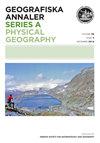重新考察拉脱维亚中部的劳尼斯剖面:首次发光结果和对波罗的海国家重要地层遗址的重新评价
IF 1.8
4区 地球科学
Q3 GEOGRAPHY, PHYSICAL
Geografiska Annaler Series A-Physical Geography
Pub Date : 2020-10-01
DOI:10.1080/04353676.2020.1813982
引用次数: 4
摘要
在层间沉积中,与有机沉积物相比,砂互层得到的关注有限,因此在古环境重建中往往代表性不足。拉脱维亚中东部的劳尼斯遗址就是一个例子,在那里,有机床已经获得了一些关注,并被用来理解斯堪的纳维亚冰盖在该地区的进退之间复杂的相互作用。砂质夹层迄今尚未被详细研究,其沉积时间也未知,因此探索这些碎屑-有机沉积物的交替是一个有趣的问题。该研究提供了一套新的发光定年方法,并从扫描电镜分析的单个石英颗粒的特征中获得了沉积学信息。砂质夹层的年代在12 - 122ka之间。在所有研究样品中,快速组分OSL信号占主导地位,但一些样品具有广泛和/或倾斜的剂量分布。只有一个样品被认为是可靠的,提供了12.0±0.6 ka的年龄。同一单元有机沉积物的放射性碳年龄为14025±270 cal y BP。这两个数据在2 sigma范围内不一致,这可能与放射性碳样品的储层和硬水效应有关。劳尼斯地点的沉积物属于格陵兰岛1号间冰期,但不可能有更详细的说明。其余的OSL年龄比预期的要老,可能是由于沉积过程中的不完全漂白。这意味着这个关键地点的地层可靠性可能会阻碍进一步的区域对比。本文章由计算机程序翻译,如有差异,请以英文原文为准。
The Raunis section, central Latvia, revisited: first luminescence results and re-evaluation of a key Baltic States stratigraphic site
ABSTRACT In interstadial deposits, sand interbeds gain limited consideration in comparison with organic sediments, and therefore tend to be underrepresented in paleoenvironmental reconstructions. The Raunis site, central-eastern Latvia, is an example where organic beds have already gained some attention and been used to understand the complex interactions between advance and retreat of the Scandinavian Ice Sheet in the region. Sandy interlayers have so far not been investigated in detail and their time of deposition has also been unknown, therefore exploring these clastic-organic sediment alternation is of interest. This study provides a new set of luminescence datings along with sedimentological information from the character of individual quartz grains as detected from scanning electron microscope analysis. Sandy interlayers are dated to between 12 and 122 ka. Fast component OSL signal dominates in all investigated samples, but several samples have broad and/or skewed dose distributions. Only one sample is considered reliable and provides an age of 12.0 ± 0.6 ka. A radiocarbon age from organic sediments in the same unit yields an age of 14 025 ± 270 cal y BP. These two dates do not agree within 2 sigma, and this is likely related to reservoir and hard water effects of the radiocarbon sample. Sediments at the Raunis site fall into the Greenland Interstadial 1, but more detailed specification is not possible. The rest of the OSL ages are older than expected, likely due to incomplete bleaching during deposition. This means that stratigraphic reliability of this key site is likely hampered for further regional correlation.
求助全文
通过发布文献求助,成功后即可免费获取论文全文。
去求助
来源期刊
CiteScore
3.60
自引率
0.00%
发文量
12
审稿时长
>12 weeks
期刊介绍:
Geografiska Annaler: Series A, Physical Geography publishes original research in the field of Physical Geography with special emphasis on cold regions/high latitude, high altitude processes, landforms and environmental change, past, present and future.
The journal primarily promotes dissemination of regular research by publishing research-based articles. The journal also publishes thematic issues where collections of articles around a specific themes are gathered. Such themes are determined by the Editors upon request. Finally the journal wishes to promote knowledge and understanding of topics in Physical Geography, their origin, development and current standing through invited review articles.

 求助内容:
求助内容: 应助结果提醒方式:
应助结果提醒方式:


